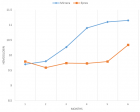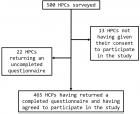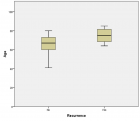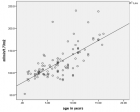Abstract
Research Article
Lipid profile of antiretroviral therapy-naive HIV-infected patients attending infectious diseases service of University Teaching Hospital of Kinshasa, Democratic Republic of the Congo (DRC)
MMK Mbula*, HNT Situakibanza, GL Mananga, B Longo Mbenza, JRR Makulo, MM Longokolo, MN Mandina, NN Mayasi, MM Mbula, B Bepouka, GL Mvumbi, BT Buasa, EN Amaela, DN Tshilumba, O Odio and A Nkodila
Published: 26 August, 2020 | Volume 4 - Issue 1 | Pages: 102-108
Introduction: HIV infection leads to metabolic disorders. The objective of this work was to study the lipid profile of HIV + patients followed at the University Teaching Hospital of Kinshasa (UTHK).
Methods: This study analyzes the lipid profile of HIV + patients, aged at least 18 years, followed at the UTHK from January 1, 2008 to December 31, 2014. The medians of different types of lipids, the frequency of lipid disorders, the general clinical characteristics of patients and factors associated with dyslipidaemia were studied. Haemoglobin (Hb), White Blood Cells (WBC), Leukocyte Formula (LF), Blood Sugar, Urea, Creatinine, Transaminases, Uric Acid, CD4s+ count were analyzed.
Results: The lipid balance was performed in 38.8% of patients; 38.1% of them had dyslipidaemia. Total hypercholesterolaemia (28.6%), elevated LDL-C (19%), hypertriglyceridemia (23.8%) and HDL hypocholesterolaemia (42.9%) were observed. The medians of TG (128 mg / dL), HDL-C (51 mg/dL) and LDL-C (78 mg/dL) were high. Risk factors associated with dyslipidaemia were represented by WHO stage 4, tuberculosis (TB) and hyperglycaemia. The highest levels of LDL-C and TG and the lowest HDL-C were seen when CD4s+ were below 200 elements/µL.
Conclusion: The HIV/AIDS dyslipidaemia characterized in this study by HDL-C hypocholesterolaemia, hypertriglyceridemia and total and LDL hypercholesterolemia can be considered as an indicator of the progression of HIV infection.
Read Full Article HTML DOI: 10.29328/journal.ijcv.1001023 Cite this Article Read Full Article PDF
Keywords:
HIV/AIDS; Lipid profile; DRC
References
- Calvez V, Dejean AG, Marcelin AG. Virologie médicale et infection VIH. In: Girard MP, Katlama C, Pialoux G, editors.VIH. Edition 2011. Paris: DOIN; 2011; 13-25.
- Carcelain G, Guihot A, Autran B. Mécanismes immunopathologiques de l’infection VIH. In: Girard MP, Katlama C, Pialoux G, editors. VIH. Edition 2011. Paris: DOIN; 2011; 465-478.
- Capeau J, Valantin MA. Altérations métaboliques et vieillissement prématuré au cours de l’infection à VIH et en réponse aux traitements antirétroviraux. In: Girard MP, Katlama C, Pialoux G, editors. VIH. Edition 2011. Paris: DOIN; 2011; 541-556.
- Feingold KR, Grunfeld C. The Effect of Inflammation and Infection on Lipids and Lipoproteins. [Updated 2019 Jan 8]. In: Feingold KR, Anawalt B, Boyce A, et al. editors. Endotext [Internet]. South Dartmouth (MA): MDText.com, Inc.; 2000. PubMed: https://www.ncbi.nlm.nih.gov/books/NBK326741/
- Pirillo A, Catapano AL, Norata GD. HDL in Infectious Diseases and Sepsis. In: von Eckardstein A., Kardassis D. (eds) High Density Lipoproteins. Handbook of Experimental Pharmacology. 2015; 224. PubMed: https://pubmed.ncbi.nlm.nih.gov/25522999/
- Waters DD, Hsue PY. Lipids abnormalities in Persons Living with HIV Infection. Canadian J Cardiol. 2019; 35: 249-259. PubMed: https://pubmed.ncbi.nlm.nih.gov/30704819/
- Maggi P, Di Biagio A, Rusconi S. Cardiovascular risk and dyslipidemia among persons living with HIV: a review. BMC Infectious Diseases 2017; 17: 551. PubMed: https://pubmed.ncbi.nlm.nih.gov/28793863/
- Utay NS, Douek DC. Interferons and HIV Infection: the Good, the Bad, and the Ugly. Pathog Immun <. 2016; 1: 107–116. PubMed: https://pubmed.ncbi.nlm.nih.gov/27500281/
- Haser GC, Sumpio B. Systemic and cell-specific mechanisms of vasculopathy induced by human immunodeficiency virus and highly active antiretroviral therapy. J Vasc Surg. 2017; 65: 849-859.
- Muswe R, Oktedalen O, Zhou DT, et al. Inflammatory Makers and Plasma Lipids in HIV Patients: A Correlation Analysis Study. Open Biochem J . 2017; 11: 105–118. PubMed: https://www.ncbi.nlm.nih.gov/pmc/articles/PMC5750726/
- Lo J. Dyslipidemaia and lipid management patients. Curr Opin Endocrinol Diabetes Obes. 2011; 18: 144–147. PubMed: https://www.ncbi.nlm.nih.gov/pmc/articles/PMC3154840/
- So-Armah K, Benjamin LA, Bloomfield GS, Feinstein MJ et al. HIV and cardiovascular disease. The Lancet HIV. 2020; 7: E279-E293.
- Low H, Hoang A, Pushkarsky T, Dubrovsky L, et al. HIV disease, metabolic dysfunction and atherosclerosis: A three-year prospective study. PLoS ONE. 2019; 14: e0215620. PubMed: https://www.ncbi.nlm.nih.gov/pmc/articles/PMC6472799/
- Kumar A, Sathian B. Assessment of lipid profile in patients with human immunodeficiency virus (HIV/AIDS) without antiretroviral therapy. Asian Pacific J Tropical Dis. 2011; 24-27.
- Giannarelli C, Klein RS, Badimon JJ. Cardiovascular implications of HIV-induced dyslipidemia. Atherosclerosis. 2011; 219: 384-389.
- Funderburg T, Mehta NN. Lipid Abnormalities and Inflammation in HIV infection. Curr HIV/AIDS Rep. 2016; 13: 218–225. PubMed: https://www.ncbi.nlm.nih.gov/pmc/articles/PMC4977198/
- Zephy D. Lipid Profile among Art Treated and Untreated Patients in HIV Positive Cases. Arch Med. 2015, 8: 2.
- Grunfeld C. Dyslipidemia and Its treatment in HIV infection. Topics. HIV Med 2010; 18: 112-118. PubMed: https://pubmed.ncbi.nlm.nih.gov/20921577/
- Sprinz E, Lazzaretti RK, Kuhmmer R, Ribeiro JP. Dyslipidemia in HIV-infected individuals. Braz J Infect Dis. 2010; 14: 575-588. PubMed: https://pubmed.ncbi.nlm.nih.gov/21340298/
- Armstrong C, Liu E, Grinspoon S et al. Dyslipidemia in an HIV-positive, antiretroviral treatment-naïve population in Dar es Salaam, Tanzania. J Acquir Immune Defic Syndr. 2011; 57: 141–145. PubMed: https://www.ncbi.nlm.nih.gov/pmc/articles/PMC3125454/
- Adewole OO, Eze S, Betiku Ye, Anteyi E, Wada I, et al. Lipid profile in HIV/AIDS patients in Nigeria. African Health Sciences. 2010; 10: 144 – 149. PubMed: https://pubmed.ncbi.nlm.nih.gov/21326966/
- Daniyam CA, Iroezindu MO. Lipid Profile of Anti‑Retroviral Treatment‑Naïve HIV‑Infected Patients in Jos, Nigeria. Ann Med Health Sci Res. 2013; 3: 26-30. PubMed: https://pubmed.ncbi.nlm.nih.gov/23634325/
- Bekolo CE, Nguena MB, Ewane L. et al. The lipid profile of HIV-infected patients receiving antiretroviral therapy in a rural Cameroonian population. BMC Public Health. 2014; 14: 236.
- Ombeni W, Kamuhabwa AR. Lipid Profile in HIV-Infected Patients Using First-Line Antiretroviral Drugs. Journal of the International Association of Providers of AIDS Care (JIAPAC). 2016; 164–171. PubMed: https://pubmed.ncbi.nlm.nih.gov/26514630/
- Zhou DT, Nehumba D, Olav Oktedalen O, et al. Changes in Lipid Profiles of HIV+ Adults over Nine Months at a Harare HIV Clinic: A Longitudinal Study. Biochem Res Int. 2016; 2016: 3204818. PubMed: https://www.ncbi.nlm.nih.gov/pmc/articles/PMC4802011/
- Ikama M, Othende FB, Makani J, et al. Global cardiovascular risk of the HIV-positive patients under antiretroviral therapy in Brazzaville. Archives of Cardiovascular Diseases Supplements. 2018; 10: 181.
- Nayyar AS. Dyslipidemia in HIV infected and AIDS patients: Association of serum lipids with HIV status, a cross-sectional study. J Med Trop. 2019; 21: 20-15. http://www.jmedtropics.org/text.asp?2019/21/1/20/263742
- Dave JA, Levitt NS, Ross IL et al. Anti-Retroviral Therapy Increases the Prevalence of Dyslipidemia in South African HIV-Infected Patients. PLoS ONE. 2016; 11: e0151911. PubMed: https://pubmed.ncbi.nlm.nih.gov/26986065/
- Anyabolu EN. Dyslipidemia in people living with HIV-AIDS in a tertiary hospital in South-East Nigeria. Pan Afr Med J. 2017; 28: 204. PubMed: https://www.ncbi.nlm.nih.gov/pmc/articles/PMC5878852/
- Singh J, Verma M, Ghalaut P, Verma R, Soni A, et al. Alteration in Lipid Profile in Treatment-Naive HIV-Infected Patients and Changes Following HAART Initiation in Haryana. J Endocrinol Metabol North America. 2014; https://www.jofem.org/index.php/jofem/article/view/207/263
- Njoroge A, Guthrie BL, Bosire R, Wener M, Kiarie J, et al. Low HDL-cholesterol among HIV-1 infected and HIV-1 uninfected individuals in Nairobi, Kenya. Lipids in Health and Disease. 2017; 16: 110.
Similar Articles
-
Lipid profile of antiretroviral therapy-naive HIV-infected patients attending infectious diseases service of University Teaching Hospital of Kinshasa, Democratic Republic of the Congo (DRC)MMK Mbula*,HNT Situakibanza,GL Mananga,B Longo Mbenza,JRR Makulo,MM Longokolo,MN Mandina,NN Mayasi,MM Mbula,B Bepouka,GL Mvumbi,BT Buasa,EN Amaela,DN Tshilumba,O Odio,A Nkodila. Lipid profile of antiretroviral therapy-naive HIV-infected patients attending infectious diseases service of University Teaching Hospital of Kinshasa, Democratic Republic of the Congo (DRC). . 2020 doi: 10.29328/journal.ijcv.1001023; 4: 102-108
Recently Viewed
-
To compare serum Vitamin D status in pre-eclamptic and non-preeclamptic pregnant women in labour: A tertiary care centre study of Northern IndiaMonica Karpa,Sita Thakur,Kamal Singh*,Jyoti Sharma,Harsha Chaudhary. To compare serum Vitamin D status in pre-eclamptic and non-preeclamptic pregnant women in labour: A tertiary care centre study of Northern India. Clin J Obstet Gynecol. 2022: doi: 10.29328/journal.cjog.1001100; 5: 013-018
-
Non-surgical Treatment of Verrucous Hyperplasia on Amputation Stump: A Case Report and Literature ReviewSajeda Alnabelsi*, Reem Hasan, Hussein Abdallah, Suzan Qattini. Non-surgical Treatment of Verrucous Hyperplasia on Amputation Stump: A Case Report and Literature Review. Ann Dermatol Res. 2024: doi: 10.29328/journal.adr.1001034; 8: 015-017
-
Outpatient operative hysteroscopy: evaluation of patient satisfaction and acceptanceClare Margaret Crowley*,Noelle Gill,Minna Geisler. Outpatient operative hysteroscopy: evaluation of patient satisfaction and acceptance. Clin J Obstet Gynecol. 2022: doi: 10.29328/journal.cjog.1001098; 5: 005-008
-
Predictors of positive treatment response to PTNS in women with overactive bladderSuneetha Rachaneni*,Doyo Enki,Megan Welstand,Thomasin Heggie,Anupreet Dua. Predictors of positive treatment response to PTNS in women with overactive bladder. Clin J Obstet Gynecol. 2022: doi: 10.29328/journal.cjog.1001097; 5: 001-004
-
Prediction of neonatal and maternal index based on development and population indicators: a global ecological studySedigheh Abdollahpour,Hamid Heidarian Miri,Talat Khadivzadeh*. Prediction of neonatal and maternal index based on development and population indicators: a global ecological study. Clin J Obstet Gynecol. 2021: doi: 10.29328/journal.cjog.1001096; 4: 101-105
Most Viewed
-
Evaluation of Biostimulants Based on Recovered Protein Hydrolysates from Animal By-products as Plant Growth EnhancersH Pérez-Aguilar*, M Lacruz-Asaro, F Arán-Ais. Evaluation of Biostimulants Based on Recovered Protein Hydrolysates from Animal By-products as Plant Growth Enhancers. J Plant Sci Phytopathol. 2023 doi: 10.29328/journal.jpsp.1001104; 7: 042-047
-
Sinonasal Myxoma Extending into the Orbit in a 4-Year Old: A Case PresentationJulian A Purrinos*, Ramzi Younis. Sinonasal Myxoma Extending into the Orbit in a 4-Year Old: A Case Presentation. Arch Case Rep. 2024 doi: 10.29328/journal.acr.1001099; 8: 075-077
-
Feasibility study of magnetic sensing for detecting single-neuron action potentialsDenis Tonini,Kai Wu,Renata Saha,Jian-Ping Wang*. Feasibility study of magnetic sensing for detecting single-neuron action potentials. Ann Biomed Sci Eng. 2022 doi: 10.29328/journal.abse.1001018; 6: 019-029
-
Pediatric Dysgerminoma: Unveiling a Rare Ovarian TumorFaten Limaiem*, Khalil Saffar, Ahmed Halouani. Pediatric Dysgerminoma: Unveiling a Rare Ovarian Tumor. Arch Case Rep. 2024 doi: 10.29328/journal.acr.1001087; 8: 010-013
-
Physical activity can change the physiological and psychological circumstances during COVID-19 pandemic: A narrative reviewKhashayar Maroufi*. Physical activity can change the physiological and psychological circumstances during COVID-19 pandemic: A narrative review. J Sports Med Ther. 2021 doi: 10.29328/journal.jsmt.1001051; 6: 001-007

HSPI: We're glad you're here. Please click "create a new Query" if you are a new visitor to our website and need further information from us.
If you are already a member of our network and need to keep track of any developments regarding a question you have already submitted, click "take me to my Query."



















































































































































